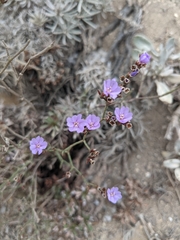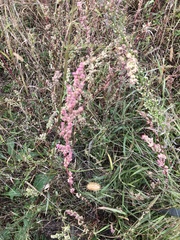Caryophyllales: taxon details and analytics
- Domain
- Kingdom
- Plantae
- Phylum
- Tracheophyta
- Class
- Magnoliopsida
- Order
- Caryophyllales
- Family
- Genus
- Species
- Scientific Name
- Caryophyllales
Summary description from Wikipedia:
Caryophyllales
Caryophyllales ( KARR-ee-oh-fih-LAY-leez) is a diverse and heterogeneous order of flowering plants with well-known members including cacti, carnations, beets, quinoa, spinach, amaranths, pigfaces and ice plants, oraches and saltbushes, goosefoots, sundews, Venus flytraps, monkey cup pitcher plants, Malabar spinach, bougainvilleas, four o'clock flowers, buckwheat, knotweeds, rhubarb, sorrel, portulacas, jojoba, and tamarisks. Many members are succulent, having fleshy stems or leaves.
The betalain pigments are unique in plants of this order and occur in all its core families with the exception of Caryophyllaceae and Molluginaceae. Noncore families, such as Nepenthaceae, instead produce anthocyanins. In its modern definition, the order encompasses a whole new group of families (formerly included in the order Polygonales) that never synthesize betalains, among which several families are carnivorous (like Nepenthaceae and Droseraceae).
According to molecular clock calculations, the lineage that led to Caryophyllales split from other plants about 111 million years ago.
...Caryophyllales in languages:
- Belarusian
- Гваздзікакветныя
- Bokmål
- nellikordenen
- Bulgarian
- Карамфилоцветни
- Catalan
- Cariofil·lals
- Chinese
- 石竹目
- Czech
- hvozdíkotvaré
- Danish
- Nellike-ordenen
- English
- pinks, cactuses, and allies
- Estonian
- nelgilaadsed
- German
- Nelkenartige
- Hungarian
- szegfűvirágúak
- Italian
- Cariofillali
- Japanese
- ナデシコ目
- Korean
- 석죽목
- Lithuanian
- Gvazdikiečiai
- Modern Greek
- Καρυοφυλλώδη
- Persian
- میخک سانان
- Polish
- Goździkowce
- Russian
- Гвоздичноцветные
- Swedish
- nejlikordningen
- Thai
- คาร์เนชัน บานไม่รู้โรย ฯลฯ
- Ukrainian
- Гвоздикоцвіті
Images from inaturalist.org observations:
We recommend you sign up for this excellent, free service.
Parent Taxon
Sibling Taxa
- Amborellales
- Apiales
- Aquifoliales
- Asterales
- Austrobaileyales
- Berberidopsidales
- Boraginales
- Brassicales
- Bruniales
- Buxales
- Canellales
- Caryophyllales
- Celastrales
- Ceratophyllales
- Chloranthales
- Cornales
- Crossosomatales
- Cucurbitales
- Dilleniales
- Dipsacales
- Ericales
- Escalloniales
- Fabales
- Fagales
- Garryales
- Gentianales
- Geraniales
- Gunnerales
- Huerteales
- Icacinales
- Lamiales
- Laurales
- Magnoliales
- Malpighiales
- Malvales
- Metteniusales
- Myrtales
- Nymphaeales
- Oxalidales
- Paracryphiales
- Picramniales
- Piperales
- Proteales
- Ranunculales
- Rosales
- Santalales
- Sapindales
- Saxifragales
- Solanales
- Trochodendrales
- Vahliales
- Vitales
- Zygophyllales
Child Taxa
- Achatocarpaceae
- Aizoaceae
- Amaranthaceae
- Anacampserotaceae
- Ancistrocladaceae
- Asteropeiaceae
- Barbeuiaceae
- Basellaceae
- Cactaceae
- Caryophyllaceae
- Didiereaceae
- Dioncophyllaceae
- Droseraceae
- Drosophyllaceae
- Frankeniaceae
- Gisekiaceae
- Halophytaceae
- Kewaceae
- Limeaceae
- Lophiocarpaceae
- Macarthuriaceae
- Microteaceae
- Molluginaceae
- Montiaceae
- Nepenthaceae
- Nyctaginaceae
- Petiveriaceae
- Physenaceae
- Phytolaccaceae
- Plumbaginaceae
- Polygonaceae
- Portulacaceae
- Rhabdodendraceae
- Sarcobataceae
- Simmondsiaceae
- Stegnospermataceae
- Talinaceae
- Tamaricaceae
Top Observation Places
- Birmingham
- Long Beach
- Geelong
- Caguas
- Brookhaven
- Moscow
- Novyye Cherëmushki
- Eugene
- Ibarra
- Ottawa
- Reno
- West Raleigh
- Boca Raton
- Lakewood
- Tucson
- Catalina Foothills
- Melbourne
- Melbourne City Centre
- Tempe Junction
- Redwood City
- Palo Alto
- Yorba Linda
- Placentia
- Neiva
- Álvaro Obregón
- Coyoacán
- Magdalena Contreras
- Hempstead
- Lubbock
- Hong Kong
- Kowloon
- Victoria
- Chicago
- West Town
- Near North Side
- Cicero
- Belmont Cragin
- Evanston
- South Lawndale
- Logan Square
- West Ridge
- Lincoln Park
- Portage Park
- Irving Park
- Berwyn
- Uptown
- Edgewater
- Rogers Park
- Oak Park
- Albany Park































































































































































